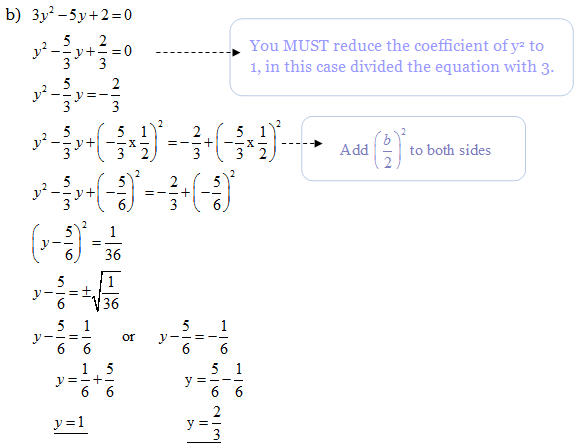Generally,  is the quadratic equation, expressed in the general form of
is the quadratic equation, expressed in the general form of  , where a=1, b=- 6 and c=5. The root is the value of x that can solve the equations.
, where a=1, b=- 6 and c=5. The root is the value of x that can solve the equations.
A quadratic equation only has two roots.
Example1: What are the roots of  ?
?
Answer: The value of 1 and 5 are the roots of the quadratic equation, because you will get zero when substitute 1 or 5 in the equation. We will further discuss on how to solve the quadratic equation and find out the roots later.
Answer: The value of 1 and 5 are the roots of the quadratic equation, because you will get zero when substitute 1 or 5 in the equation. We will further discuss on how to solve the quadratic equation and find out the roots later.
1) Solve the quadratic equations
There are many ways we can use to solve quadratic equations such as using:
1) substitution,
2) inspection,
3) trial and improvement method,
4) factorization,
5) completing the square and
6) Quadratic formula.
2) inspection,
3) trial and improvement method,
4) factorization,
5) completing the square and
6) Quadratic formula.
However, we will only focus on the last three methods as there are the most commonly use methods to solve a quadratic equation in the SPM questions. Let’s move on!
Factorization
Factorization is the decomposition of a number into the product of the other numbers, example, 12 could be factored into 3 x 4, 2 x 6, and 1 x 12.
Example 2: Solve  using factorization.
using factorization.
Answer: We can factor the number 12 into 4 x 3. Remember, always think of the factors which can be added up to the get the middle value (3+4 = 7), refer factorization table below,
Answer: We can factor the number 12 into 4 x 3. Remember, always think of the factors which can be added up to the get the middle value (3+4 = 7), refer factorization table below,
So we will get ( x + 3 )( x + 4 ) = 0,
x + 3 = 0 or x + 4 = 0
x = – 3 or x = – 4
x + 3 = 0 or x + 4 = 0
x = – 3 or x = – 4
Example 3: Solve  using factorization.
using factorization.
Answer: Rearrange the equation in the form of
Answer: Rearrange the equation in the form of
So we will get (4x – 3)(2x – 1)=0,
4x – 3 = 0 or 2x – 1 = 0
x = or x =
or x = 
4x – 3 = 0 or 2x – 1 = 0
x =
Completing the square
Example 4: Solve the following equation by using completing the square method.
Quadratic formula
Normally when do you need to use this formula?
1) The exam question requested to do so!
2) The quadratic equation cannot be factorized.
3) The figure of a, b, and c of the equation are too large and hard to factorized.
are too large and hard to factorized.
2) The quadratic equation cannot be factorized.
3) The figure of a, b, and c of the equation
Example 5: Solve  using quadratic formula.
using quadratic formula.
2) Form a quadratic equation
How do you form a quadratic equation if the roots of the equation are 1 and 2? Well, we can do the work out like this using the reverse method:
We can assume:
x = 1 or x = 2
x – 1 = 0 or x – 2 = 0
x – 1 = 0 or x – 2 = 0
(x-1)(x-2)=0
x2-2x-x+2=0
x2-3x+2=0
x2-2x-x+2=0
x2-3x+2=0
So the quadratic equation is x2 – 3x + 2=0. This is the most basic technique to form up a quadratic equation.
Let’s assume we have the roots of  and
and  :
:
In other words, we can form up the equation using the sum of roots (SOR) and product of roots (POR). If the roots are 1 and 2,
SOR = 1+2
= 3
= 3
POR = 1 x 2
=2
=2
Sometime we need to determine the SOR and POR from a given quadratic equation in order to find a new equation from a given new roots. In general form,
Let’s look at the example below on how the concept above can help us solve the question.
Example 6: Given that  and
and  are the roots of
are the roots of  , form a quadratic equation
, form a quadratic equation  with the roots of (
with the roots of ( – 5 ) and (
– 5 ) and (  – 5 ).
– 5 ).
3) Determine the conditions for the type of roots
Refer back to example 2, we know that  has two different roots (-3 and -4) by solving using factorization method. However, how are we going to determine the types of roots of
has two different roots (-3 and -4) by solving using factorization method. However, how are we going to determine the types of roots of  without solving the equation? The trick is we can use
without solving the equation? The trick is we can use  .
.
From the quadratic equation,  ,
,  , we have 2 different roots since the discriminant is greater than zero. Refer table below.
, we have 2 different roots since the discriminant is greater than zero. Refer table below.
Example 7: A quadratic equation  has two equal roots. Find the possible values of h.
has two equal roots. Find the possible values of h.
Done by ; swaggy anis and lame aniyah











